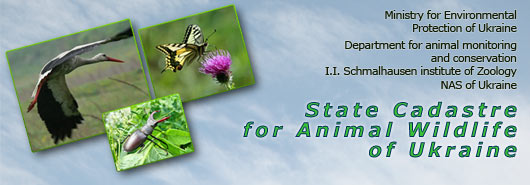
The idea of establishing a state cadastre for plant and animal wildlife arised in the former USSR far back in the 80’s of the past century. A few conferences were held on the topic, quite a number of publications appeared, but the disintegration of the Soviet state brought the process to a standhold. Only in 2001, under the initiative of the Ministry of Environmental Protection of Ukraine (MEPU), the issue was raised once again.
In compliance with the acting legislation (Enactment of the Council of Ministers of Ukraine “On the Maintenance of the State Cadastre for Animal Wildlife” dated 15th of November 1994, No.772), the State Cadastre for Animal Wildlife is a systematized body of information about the geographical distribution of species (groups of species) of animals, their numbers and condition, habitat features and contemporary economic use, other sorts of information necessary for securing their protection and sustainable use.
The State Cadastre for Animal Wildlife is expected to cover the whole land area of Ukraine, the country’s continental shelf and exclusive (marine) economic zone.
Elaboration of the State Cadastre for Animal Wildlife expects the collection of all existing information concerning the issue (publications, sectoral and governmental statistical reports etc.), field surveys, analysis of collated data and its generalization.
Efforts on elaborating the State Cadastre for Animal Wildlife are organized and coordinated by MEPU and its local departments.
To date the I.I.Schmalhausen Institute of Zoology NASU, on the request of MEPU, has created a GIS-associated data base to which data is entered upon animal wildlife in Ukraine. Taking into account the number of animal species in Ukraine, reaching an estimated 45 thousand, and the rich yield of information resulting from current investigations, the data base is permanently being developed and is considerably expanding. Priority in the meantime is given to species in an urgent need of protection (the Red Data Book of Ukraine, international “red lists”, appendices to nature conservation conventions), game species, alien invasive animal species.
Gradually the accumulated body of information is made accessible to the public through the Internet, specifically via this website.
